Bear Collisions: The Shocking $5,000 Cost & How to Avoid It
Stop bear collisions with revolutionary thermal imaging! Crucial night driving strategies revealed. Don’t miss out!
Picture this: you’re driving at night when suddenly a black bear darts into the road. Can you brake in time? This isn’t just a scary idea—it’s a real risk many drivers face. Every year in the U.S., thousands of vehicle-wildlife collisions involve bears. While bear accidents aren’t the most common, they are among the most dangerous.
Imagine driving on a dark mountain road. You see a shadow move. By the time you react, it’s too late. Hitting a bear can be fatal for the animal, cause severe vehicle damage, and put lives at risk.
This article will help you understand why bear collisions happen and how to prevent them using advanced thermal imaging technology. You’ll learn practical and high-tech ways to stay safe while night driving.
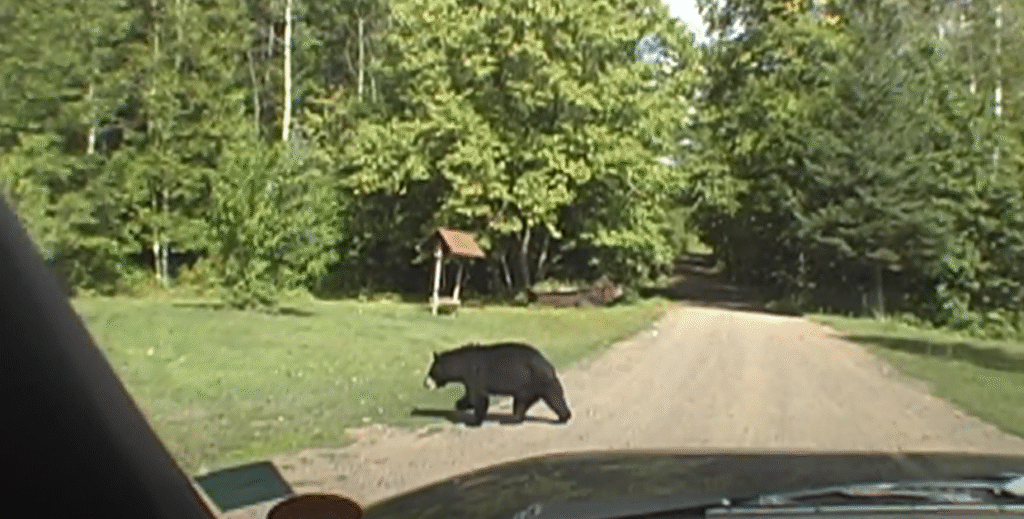
Why Are Bear Collisions an Underestimated Risk?
Many drivers underestimate the risk of hitting a bear at night. Let’s look at the numbers.
Statistics on Wildlife-Vehicle Collisions
The AAA Foundation for Traffic Saf1ety reports roughly 1.5 million wildlife-vehicle collisions each year in the U.S. Bears are involved in several thousand of these, according to estimates from the National Agricultural Statistics Service and other agencies.
These accidents are costly. The average property damage from a bear collision is over $5,000. Injuries can also be serious.
High-Risk Areas and Times
You might think, “It won’t happen to me.” But the risk is higher than you realize—especially near forests, mountains, or national parks. For example, roads around Yellowstone National Park see regular bear collisions because they cross through bear habitats.
Bears are also most active when many people are driving: at dawn, dusk, and during the night. When visibility is low, accidents are more likely during night driving.
The main challenge is that black bears are hard to see in the dark. Their fur blends into the road and shadows. They move quickly, so drivers often notice them too late.
Next, let’s look at why bears are so hard to spot and what you can do about it.
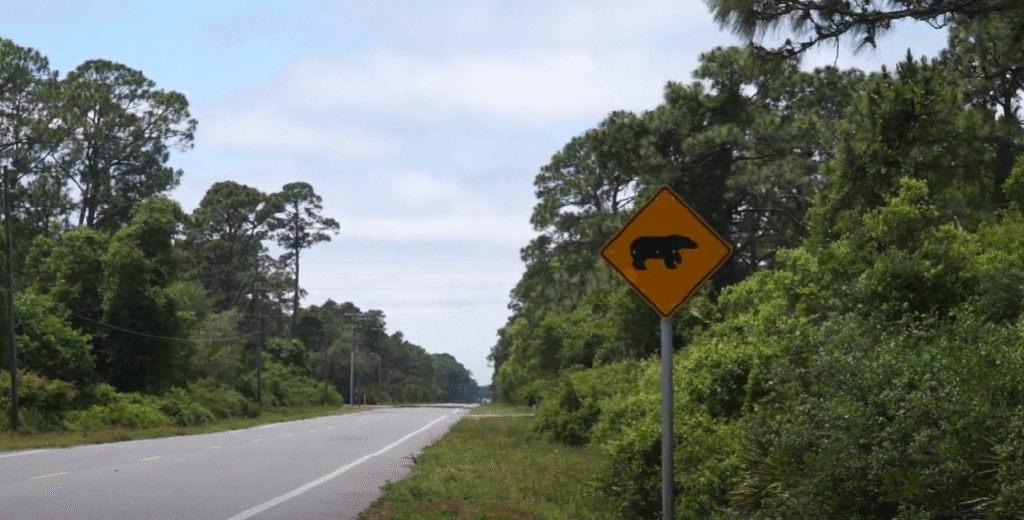
Why Are Black Bears So Hard to See?
It’s not just one thing—it’s a mix of bear behavior, human vision limits, and outdated car equipment.
Biology and Behavior of Black Bears
Black bears have dark fur. This helps them “disappear” against asphalt and wooded backgrounds at night, making wildlife detection challenging.
They are also crepuscular. This means they are most active at twilight and during the night. Unfortunately, that’s when many people are driving to or from work or recreation.
Bears can also move fast. They can cross a road in seconds, leaving little time for drivers to respond—a major concern for night driving safety.
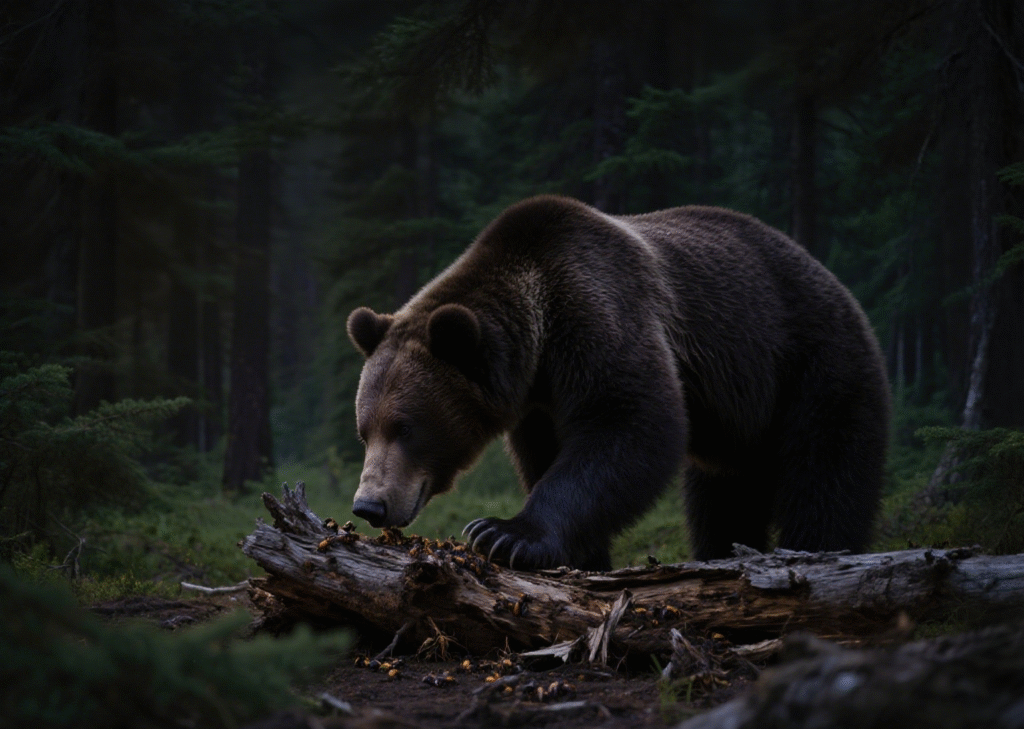
Limits of Human Vision at Night
Human eyes don’t see well in the dark. We lose the ability to distinguish details and contrast in low light, making animal detection difficult.
Headlights help, but they only light up about 30–60 meters of road ahead. According to the National Highway Traffic Safety Administration (NHTSA), that’s not enough at higher speeds. On curves or hills, headlights are even less effective. Blind spots form, and a bear might be hidden in one of them.
People also have slow reaction times. It takes between 0.5 and 1 second to see danger, process it, and hit the brakes. At 60 miles per hour, your car travels 88 feet in one second. That could be enough to cause a crash.
The Shortcomings of Standard Car Equipment
You might think your headlights, infrared night vision, or dashcam are enough for wildlife detection. But they all have flaws.
Standard headlights don’t reach far. Fog, rain, or snow makes them even less effective. High beams help but must be dimmed for other drivers.
Infrared night vision systems need some ambient light. They don’t work as well in pitch darkness or bad weather, limiting their effectiveness for animal detection.
Dashcams only record video. They don’t warn you before a collision, offering no protection against bear collisions.
This is why so many bear accidents happen. Drivers can’t see the bear in time with conventional night vision systems.
Why Do Bear Collisions Happen? A Deeper Look.
Bear collisions don’t happen without reason. There are three main causes: environment, driver behavior, and technology limits.
Environmental Factors
Location matters. Bears often live in mountains, forests, and near national parks. Roads in these areas are riskier for night driving.
Weather is another factor. Rain, fog, or light snow make it harder to see. Wet roads also increase stopping distance, complicating wildlife detection and avoidance.
Seasonal behavior counts, too. In fall, bears eat more to prepare for winter. They roam farther and cross roads more often, increasing the risk of bear collisions.
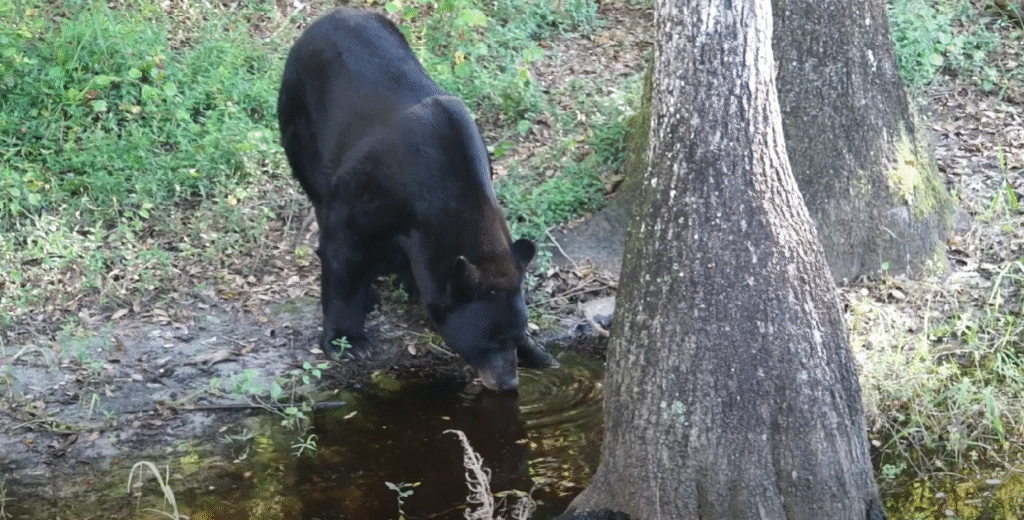
Driver Behavior
Sometimes, the driver’s actions play a big role in bear collisions.
Speed is a major problem
Driving too fast leaves less time to react. NHTSA research shows that for every 10 mph increase in speed, the risk of a wildlife collision rises by 20–30%.
Distraction is another issue
Looking at your phone, changing music, or talking to passengers takes your eyes off the road. At night, you need full attention to spot hazards and prevent bear collisions.
Some drivers rely too much on their headlights. But headlights have limits. They can’t light up everything, especially around curves or over hills, making wildlife detection difficult.
Technical Limits of Current Systems
Many cars lack advanced wildlife collision avoidance technology. Basic driver-assist tech (ADAS) can detect cars and people but often misses animals like bears.
Standard night vision systems use infrared light. As we said, these don’t work well in total darkness or bad weather, limiting their effectiveness for animal detection.
These technical gaps leave drivers unprotected against sudden bear encounters during night driving.
How to Prevent Bear Collisions – A Multi-Layer Safety Plan
You need more than one strategy to avoid bear collisions. Here’s how to avoid hitting a bear while driving using driving habits, car upgrades, and technology.
Driving Tips (The Basics)
Start with how you drive.
Slow down in areas marked with wildlife warnings. Reducing your speed gives you more time to brake and avoid bear collisions.
Use high beams wisely. Turn them on when no other cars are near. Switch to low beams when others are approaching.
Stay focused. Don’t use your phone or other devices. If you’re tired, pull over and rest to ensure safe night driving.
One useful trick: honk your horn when driving near woods or thick brush. It may scare bears away from the road, helping prevent bear collisions.
Vehicle Upgrades (Next-Level Protection)
Better equipment can help a lot with wildlife detection.
Consider upgrading to LED or laser headlights. They shine farther and brighter than standard lights, improving visibility during night driving. Just make sure they’re legal and aimed correctly.
Install a professional thermal night vision system for cars. Thermal imaging tech is best because it doesn’t need light to work. It detects heat signatures, so it can see bears in total darkness or light fog, providing superior animal detection.
You can also add a bull bar or reinforced bumper. These won’t prevent a crash, but they might reduce damage and injuries from bear collisions.
Tech Assistance: AI + Thermal Imaging (Top Protection)
Advanced tech offers the best protection against bear collisions.
Thermal imaging cameras detect heat, not light. Since bears are warm-blooded, they show up clearly—even in bad weather, making them ideal for night driving safety.
AI recognition makes the system smarter. It can tell the difference between people, cars, and animals. It alerts you early and can predict where the bear is moving, enhancing wildlife detection capabilities.
Research shows thermal imaging can reduce animal collisions by up to 60%. For example, a student team from STEM School Highlands Ranch in Colorado developed a device using AI recognition and thermal imaging. It can detect deer and other animals from about 500 feet away.
This wildlife collision avoidance technology works. It gives drivers time to react during night driving.
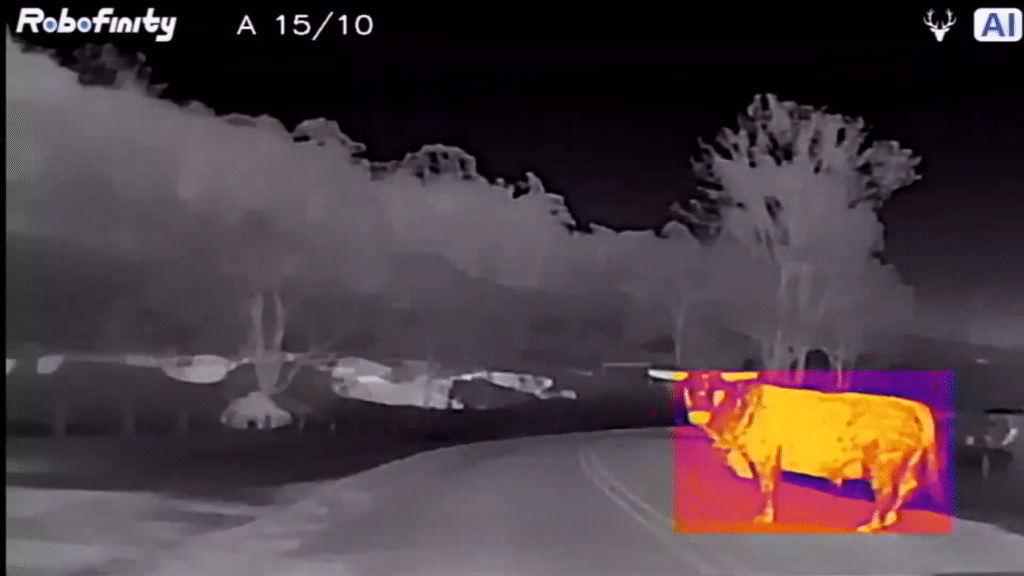
Why Traditional Gear Isn’t Enough – Thermal Imaging Is the Future
Standard night vision systems have too many flaws for effective wildlife detection.
Infrared night vision needs some light. It fails in total darkness. It also struggles in rain, snow, or fog, making it unreliable for animal detection during night driving.
Thermal imaging doesn’t need any light. It works in all conditions because it sees heat signatures, not light. This makes it perfect for how to avoid hitting a bear while driving in various conditions.
That’s why thermal imaging tech is the future of night driving safety and wildlife collision avoidance technology.
Based on our testing, devices like the Robofinity InsightDrive are leading the way in thermal night vision system for cars. It has a thermal resolution of 384×512 and uses AI recognition to enhance images to 1024×768. That means clearer, more detailed pictures for better animal detection.
It can detect bears up to 656 feet away—well beyond standard headlight range. That’s plenty of time to slow down or stop during night driving.
The Robofinity InsightDrive is also waterproof (rated IP67), so rain or snow won’t stop it. It uses very little power, so it won’t drain your battery.
It turns on automatically with your car. The app lets you customize alerts and settings. According to user reviews, it’s easy to install and use for night driving protection.
With AI thermal imaging for drivers like this, you can drive at night with much more confidence and significantly reduce the risk of bear collisions.
How to Choose and Use a Thermal Night Vision System
Not all thermal imaging systems are the same. Follow these steps to pick and use the right thermal night vision system for cars.
Check the Thermal Resolution and Frame Rate
Resolution matters for effective wildlife detection. Higher resolution means clearer images. Look for at least 384×512. AI super-resolution is a bonus for animal detection.
Frame rate affects smoothness. Choose at least 25Hz for clear video of moving animals during night driving.
Make Sure It Recognizes Wildlife
Not all AI recognition systems can identify bears. Choose one trained specifically for wildlife detection. Systems trained on 200,000+ images can be over 95% accurate for animal detection.
Install It High and Clear
Mount the camera high on your windshield. This maximizes view and reduces blind spots for better wildlife detection. Make sure nothing blocks the lens during night driving.
Set Your Alert Distance and Style
Adjust the alert distance to your driving. On highways, set it far—around 200 meters. On slower roads, you can reduce it to optimize wildlife collision avoidance technology.
Use both sound and visual alerts. Sound gets your attention. Visual cues show where the bear is, enhancing animal detection during night driving.
Use the App for Custom Settings
Many systems come with an app. Use it to adjust sensitivity and get software updates for your thermal night vision system for cars.
If alerts are too frequent, lower the sensitivity. If you’re missing alerts, raise it to improve wildlife detection.
OTA updates keep your system improving over time, ensuring your AI thermal imaging for drivers remains effective.
Conclusion: Drive Safe, Stay Alert, and Use the Right Tech
Bear collisions are a real risk during night driving. But you can reduce it with knowledge and the right tools.
Change how you drive. Slow down in wildlife areas. Stay focused to avoid bear collisions.
Upgrade your equipment. Better lights help. Thermal imaging helps even more with wildlife detection.
According to user reviews, devices like the Robofinity InsightDrive offer peace of mind for how to avoid hitting a bear while driving. They work in all conditions and give early warnings through advanced AI recognition.
Tech is a great helper, but you are the driver. Stay alert, drive carefully, and always be prepared with proper wildlife collision avoidance technology.
With these tips and the right thermal night vision system for cars, you can enjoy safer night driving—wherever the road takes you.
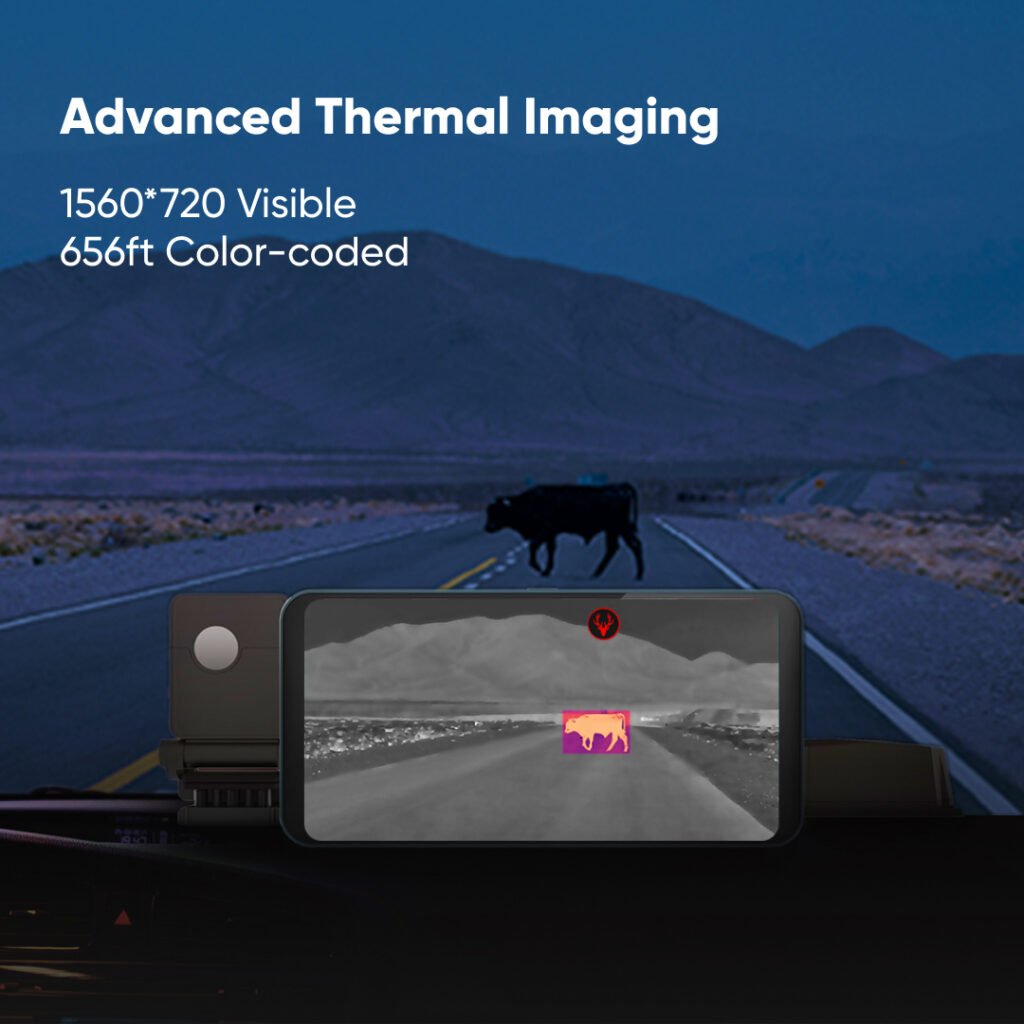
Ready to drive with confidence? Explore the Robofinity InsightDrive today and experience the next level of night driving safety with advanced thermal imaging and AI recognition technology.

